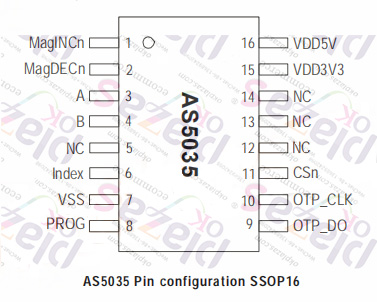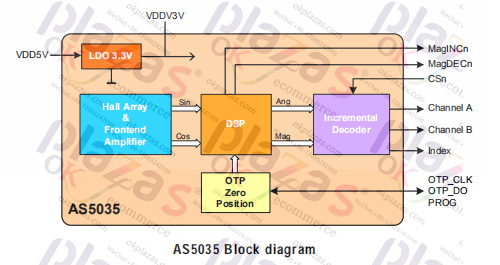Introduction of 8-bit non-contact magnetic incremental encoder AS5035
Introduction of 8-bit non-contact magnetic incremental encoder AS5035
Introduction of 8-bit non-contact magnetic incremental encoder AS5035
main feature
-Full rotation (360°) non-contact angle position encoder
-2 quadrature A/B outputs, 64 pulses per revolution (ppr), 256 edges per revolution, 1.4° per step
-Precise user programmable zero position
-Exponential output (one pulse per revolution)
-Fault detection mode monitoring and power failure for magnet placement
-Wide temperature range: -40°C to +125°C
-Small lead-free packaging: SSOP 16 (5.3mm x 6.2mm)
application
-Industrial applications:
-Robotics
-Replacement of optical encoder
-Flowmeter
-HMI
-Automotive application:
-Power seat position sensing
-Electric rearview mirror position sensing
Pin configuration


General description
AS5035 is a non-contact magnetic incremental encoder with 64 quadrature pulses (8-bit resolution) and index output per revolution.
Only a simple two-pole magnet is needed to rotate in the center of the chip. The magnet can be placed above or below the integrated circuit.
The angular position of the magnet during the assembly process is not important, because AS5035 allows the user to program the zero accuracy to 0.35.
Two diagnostic outputs are provided to indicate the out-of-range magnetic field and the movement of the magnet on the Z axis. In addition, a specific combination of output states indicates a power interruption.
AS5035 has a small 16-pin SSOP package. It can work under 3.3V or 5V power supply.

benefit
-Complete system chip, including analog front end and digital signal processing;
-2 channel quadrature and index output provide an alternative to optical encoder;
-User-programmable OTP zero-point positioning, which is convenient for magnet assembly;
-Operational safety diagnostic features;
-Due to the principle of magnetic induction, it is very suitable for use in harsh environments;
-Rugged system that can withstand magnet misalignment, air gap changes, temperature changes and external stray magnetic fields.





